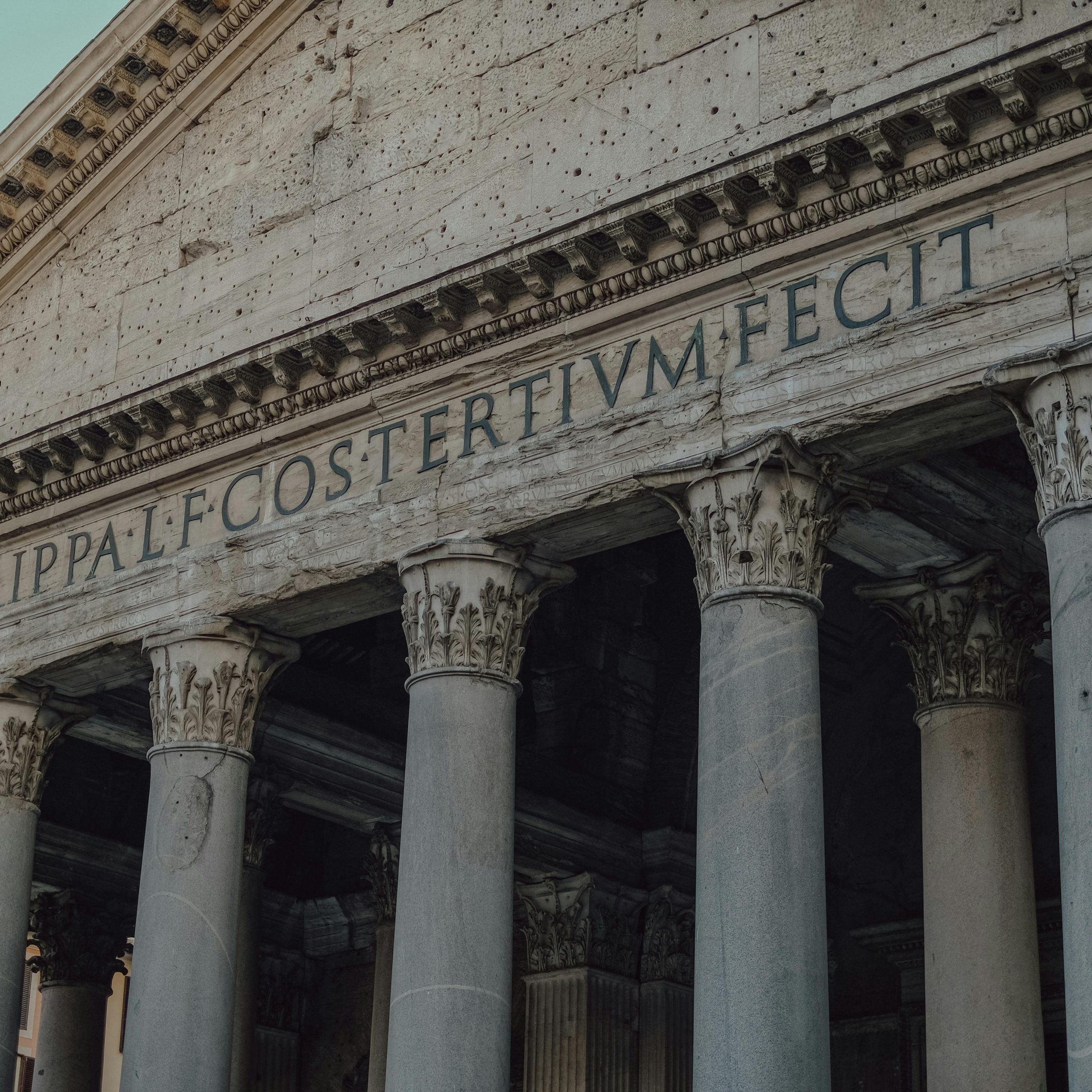
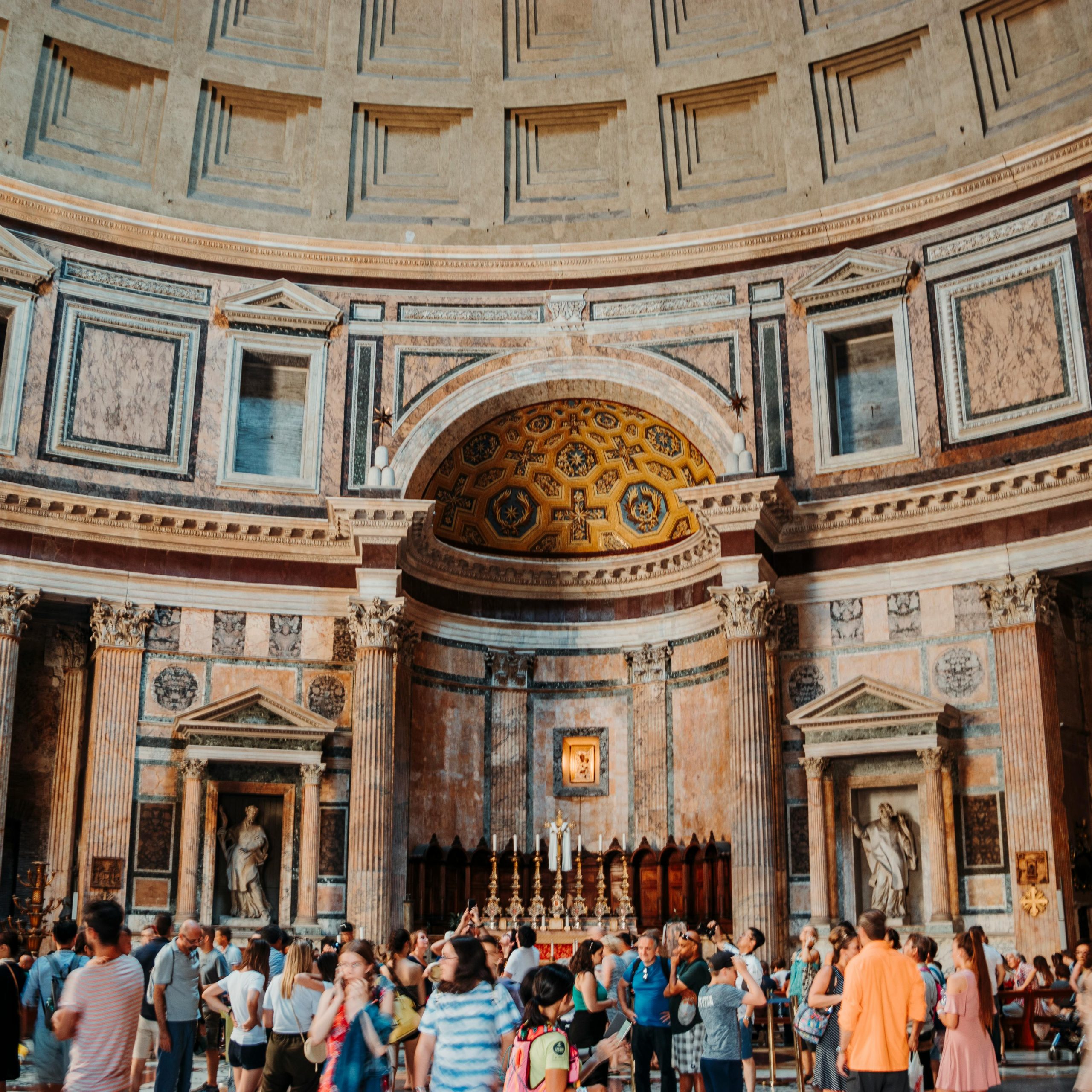
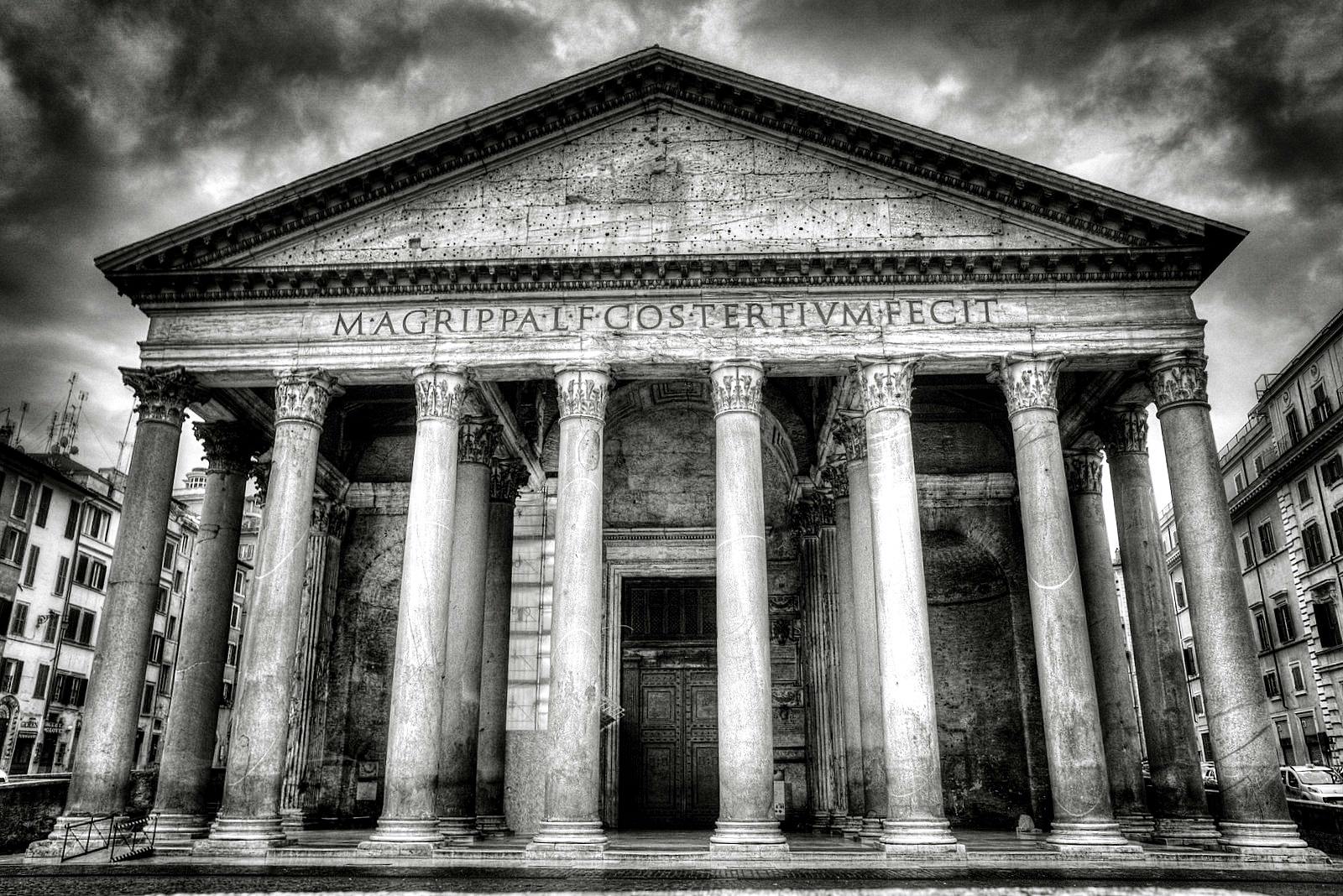
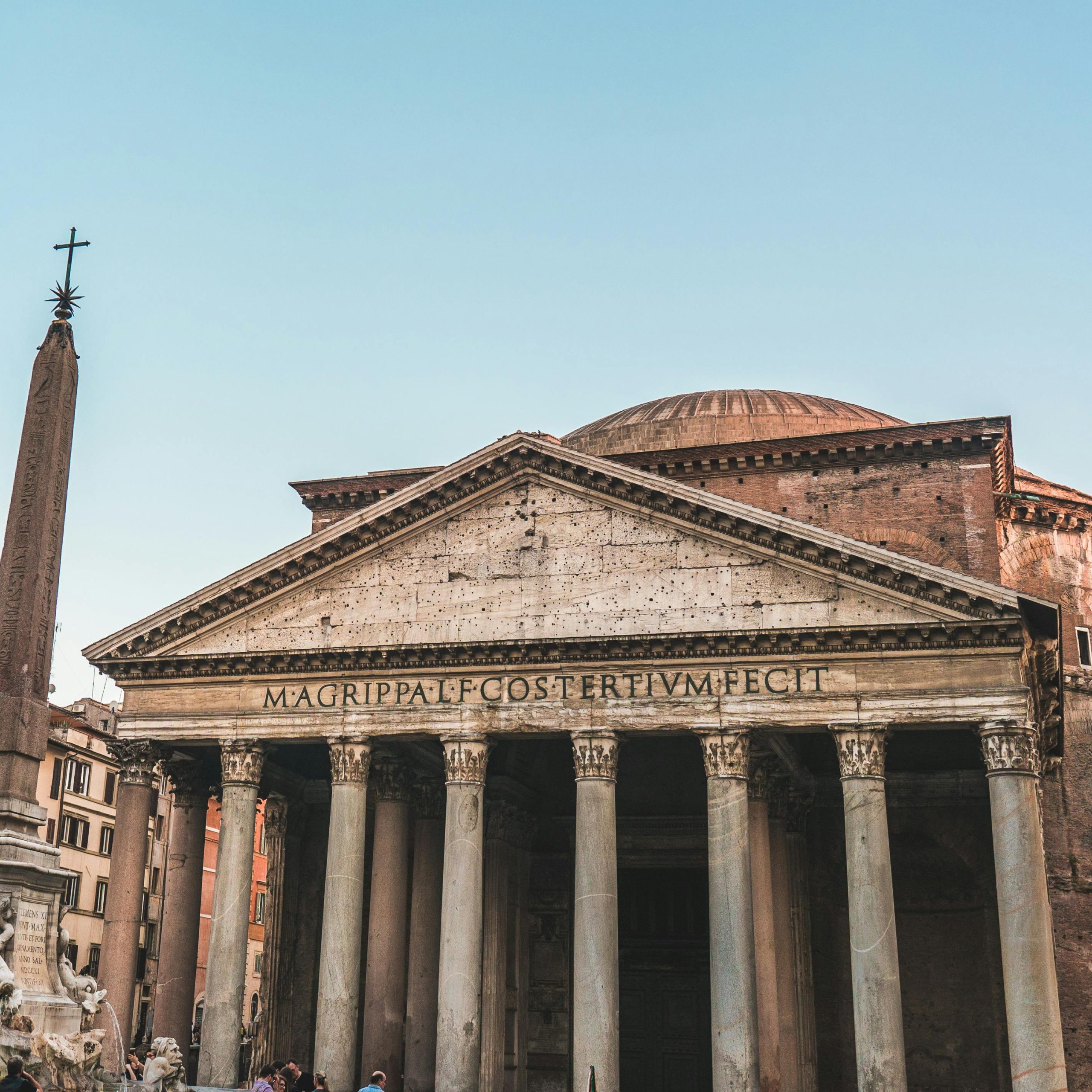
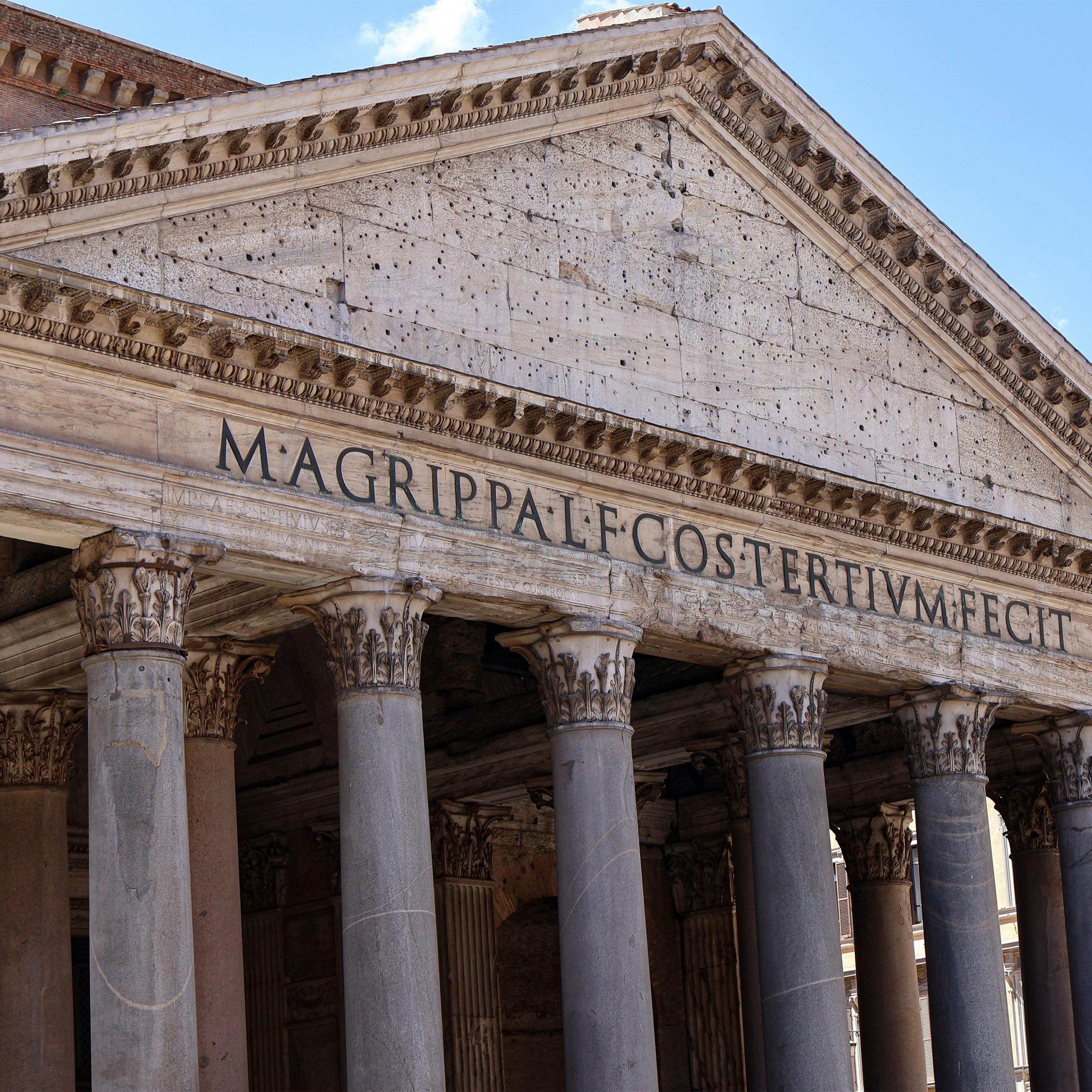
A true architectural marvel, the Pantheon stands as a defining landmark of Rome. Located in the historic center, it is a must-see attraction for visitors. Its massive dome, grand entrance, and incredible history make it a highlight of any Rome tour. Walking through the Pantheon feels like stepping back in time to ancient Rome. Many visitors find themselves in awe of the scale and beauty of the building, making it a perfect place to take photos and admire Roman engineering up close.
If you love history, the Pantheon is a must-visit. It was first built over 2,000 years ago and has been in continuous use ever since. This ancient Roman temple has witnessed emperors, kings, and popes. Today, it is a church, a historical site, and a marvel of architecture. The Pantheon is a unique mix of Roman and Christian heritage, making it one of the most well-preserved ancient structures in the world. Every brick and column tell a story about the empire’s strength and ingenuity.
Rome is full of ancient ruins, but the Pantheon is different. Unlike the Colosseum or the Roman Forum, the Pantheon is still complete. Its incredible preservation allows visitors to see it just as the Romans did centuries ago. Many historical buildings from ancient times exist only as partial ruins, but the Pantheon remains whole, giving an immersive experience of the past. Its transformation into a church helped protect it from destruction, ensuring its legacy continues into the modern age.
The Pantheon has inspired architects around the world. Its grand dome has influenced famous buildings like the U.S. Capitol and St. Peter’s Basilica. Engineers still study its design to understand how the Romans built such an advanced structure. The concept of the oculus, the open hole at the top of the dome, has been used in many contemporary designs. Additionally, the way Roman concrete was mixed and applied in the Pantheon continues to be a topic of interest in modern engineering.
The first Pantheon was built in 27 BCE by Marcus Agrippa, a general under Emperor Augustus. It was a temple dedicated to all Roman gods. However, the original building was destroyed by fire. Agrippa’s vision was to create a space where all gods could be worshipped under one roof, a concept that was quite revolutionary at the time. The early structure laid the foundation for what would later become one of Rome’s greatest architectural achievements.
In 118-125 CE, Emperor Hadrian rebuilt the Pantheon. This is the version we see today. Hadrian kept Agrippa’s name on the front, which is why it still says “Marcus Agrippa” on the facade. Hadrian was known for his love of Greek culture and incorporated classical Greek influences into the Pantheon’s design. This was a time of immense architectural experimentation, and the Pantheon became a symbol of Rome’s ability to merge different styles into one enduring structure.
In 609 CE, the Pantheon was converted into a Christian church. This helped protect it from destruction, unlike many other Roman temples that were abandoned or destroyed. The conversion ensured the Pantheon remained a place of worship rather than a quarry for building materials, which was the fate of many ancient Roman structures. It was rededicated to St. Mary and the Martyrs, and to this day, it serves as an active church where services and ceremonies take place.
The Pantheon’s perfect proportions and massive dome have inspired buildings worldwide. Many Renaissance and modern architects have copied its design. The concept of large domed structures was rare before the Pantheon, and its construction method laid the foundation for iconic domed buildings such as the Florence Cathedral and the U.S. Capitol. Its impact on neoclassical architecture is seen across Europe and the Americas.
Despite wars, earthquakes, and time, the Pantheon has remained standing. Its strong Roman concrete has allowed it to survive for over 2,000 years. The secret lies in the way the Romans mixed their concrete, using volcanic ash that made it incredibly durable. While other monuments fell into ruin, the Pantheon continued to be used, restored, and respected, allowing it to stand as a proud reminder of Rome’s golden age.
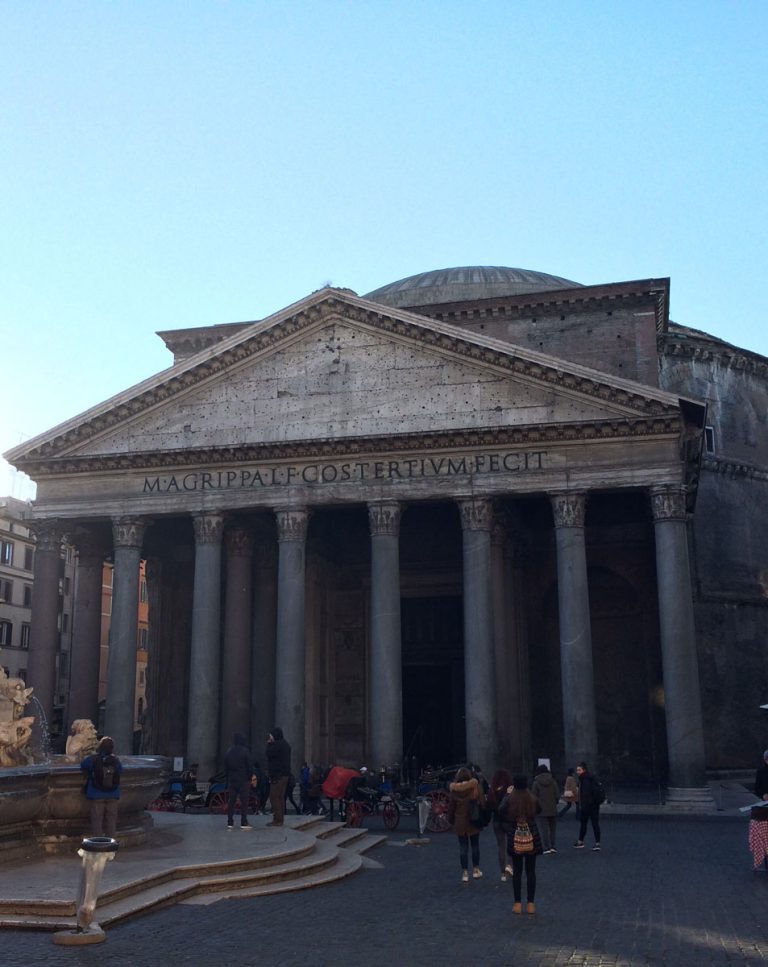
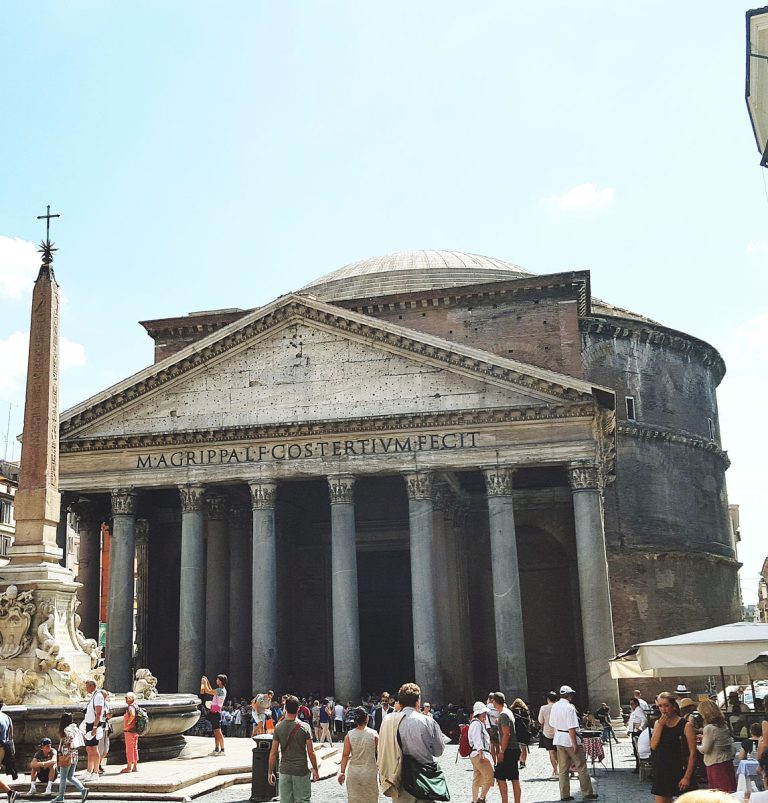
The Pantheon’s dome is a masterpiece. At 43.3 meters in diameter, it remains the largest unreinforced concrete dome in the world. This was an incredible engineering achievement at the time and continues to be an architectural wonder. The way the dome distributes weight is still studied in architectural schools today, as modern technology still struggles to match the Romans’ ingenuity in creating such massive structures without reinforcement.
At the center of the dome is the oculus, an open hole that lets in natural light. It also helps distribute the dome’s weight evenly. The oculus serves both an engineering and a symbolic purpose, as it represents a connection between the heavens and the earth. During the daytime, sunlight streams through the opening, illuminating the vast interior. On rainy days, the water enters but drains through a sophisticated drainage system hidden in the floor.
The entrance of the Pantheon has 16 massive Corinthian columns. These columns were imported from Egypt, showing the power of the Roman Empire. Each column is made from a single piece of granite, transported across the Mediterranean. The ability to bring such massive stones from Egypt to Rome is a testament to the efficiency and organization of the Roman Empire’s trade and transportation networks.
The Pantheon is perfectly symmetrical. The height from the floor to the oculus is equal to the diameter of the dome. This precision in design creates a feeling of balance and harmony when you step inside. Architects throughout history have admired and replicated this sense of perfection in their own works, making the Pantheon one of the most studied buildings in history.
The Pantheon was built with Roman concrete, which is stronger than modern concrete. It also features beautiful marble from different parts of the Roman Empire. The use of different colored marbles from Egypt, Asia Minor, and North Africa adds to the temple’s aesthetic appeal. The Pantheon was not just an engineering marvel; it was also a display of Rome’s vast resources and global reach.
The Pantheon’s dome is a masterpiece. At 43.3 meters in diameter, it remains the largest unreinforced concrete dome in the world. This was an incredible engineering achievement at the time and continues to be an architectural wonder. The way the dome distributes weight is still studied in architectural schools today, as modern technology still struggles to match the Romans’ ingenuity in creating such massive structures without reinforcement.
At the center of the dome is the oculus, an open hole that lets in natural light. It also helps distribute the dome’s weight evenly. The oculus serves both an engineering and a symbolic purpose, as it represents a connection between the heavens and the earth. During the daytime, sunlight streams through the opening, illuminating the vast interior. On rainy days, the water enters but drains through a sophisticated drainage system hidden in the floor.
The entrance of the Pantheon has 16 massive Corinthian columns. These columns were imported from Egypt, showing the power of the Roman Empire. Each column is made from a single piece of granite, transported across the Mediterranean. The ability to bring such massive stones from Egypt to Rome is a testament to the efficiency and organization of the Roman Empire’s trade and transportation networks.
The Pantheon is perfectly symmetrical. The height from the floor to the oculus is equal to the diameter of the dome. This precision in design creates a feeling of balance and harmony when you step inside. Architects throughout history have admired and replicated this sense of perfection in their own works, making the Pantheon one of the most studied buildings in history.
The Pantheon was built with Roman concrete, which is stronger than modern concrete. It also features beautiful marble from different parts of the Roman Empire. The use of different colored marbles from Egypt, Asia Minor, and North Africa adds to the temple’s aesthetic appeal. The Pantheon was not just an engineering marvel; it was also a display of Rome’s vast resources and global reach.
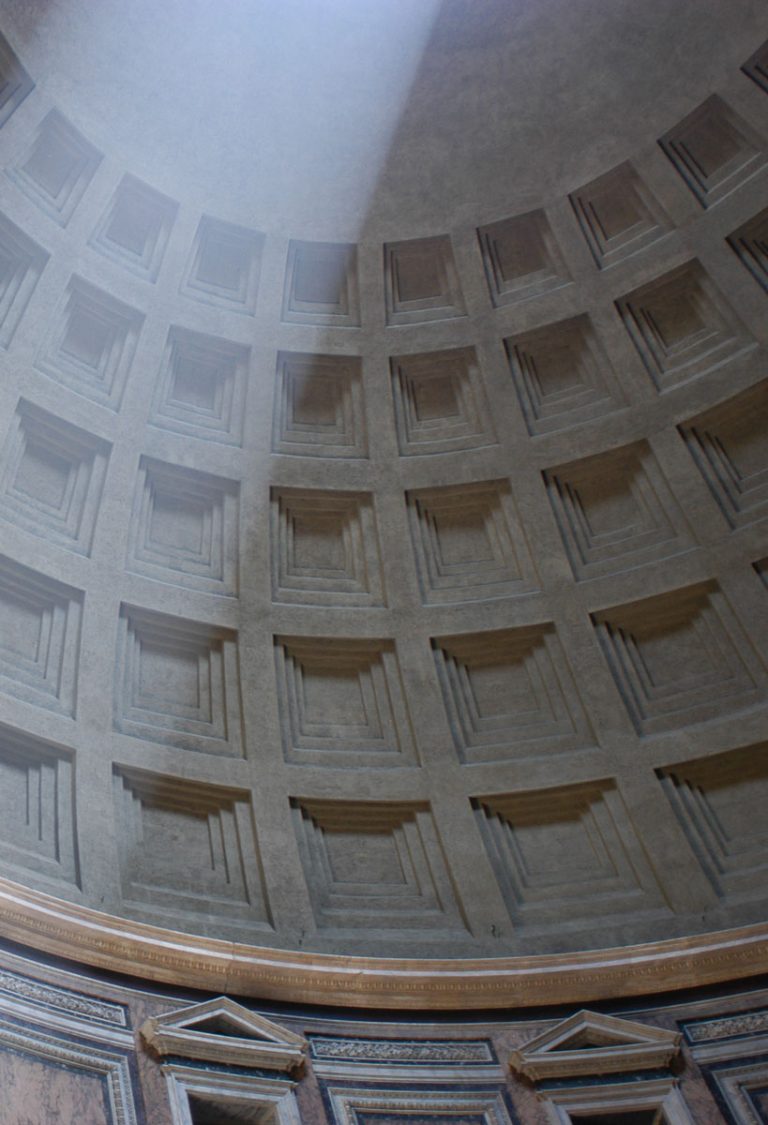
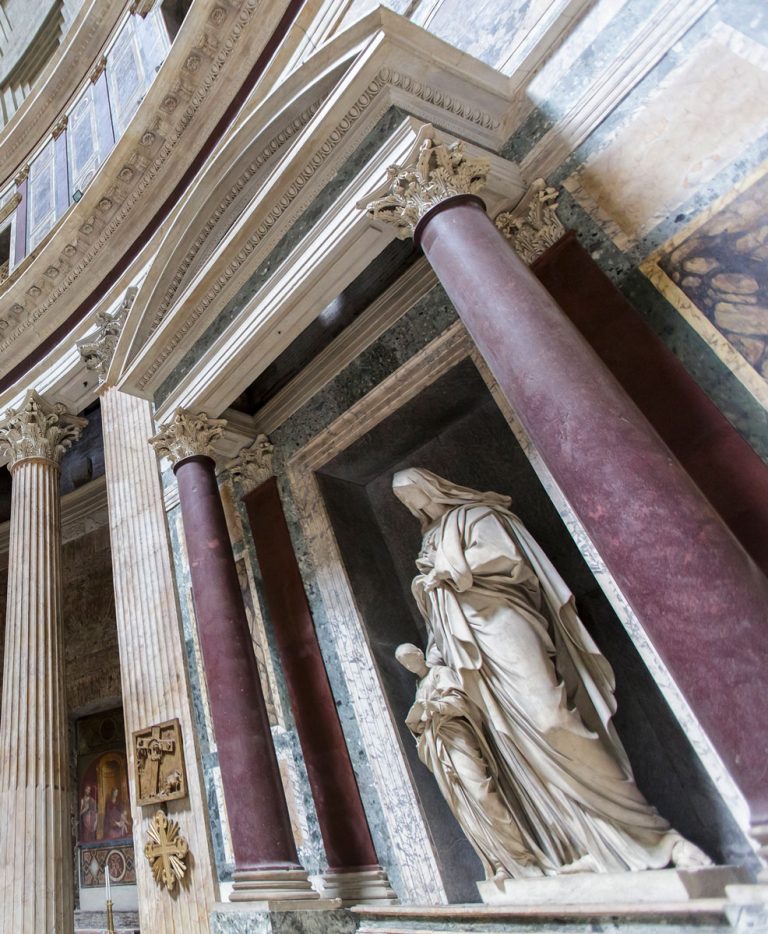
One of the most famous features inside the Pantheon is the tomb of Raphael, the great Renaissance artist. Raphael requested to be buried here, and his tombstone bears an inscription in Latin honoring his artistic genius. Visitors from around the world come to pay their respects to this master of art, whose works, including the frescoes in the Vatican, have left a lasting impact on the world of painting.
In addition to Raphael, the Pantheon is also the final resting place of Italian kings, including Victor Emmanuel II and Umberto I. These royal tombs make the Pantheon a site of national significance in Italy. The presence of these tombs highlights the monument’s long-standing role in Italian history, not just as an ancient temple but also as a national mausoleum.
Since its conversion into a church in 609 CE, the Pantheon has housed various Christian relics and religious artifacts. The high altar, which is still used for religious ceremonies today, is a stunning piece of art and devotion. The intricate design and golden decorations of the altar add to the grandeur of the building’s interior.
The marble floors inside the Pantheon feature intricate patterns and designs that reflect the artistic mastery of ancient Rome. The variety of colored marbles, sourced from different parts of the Roman Empire, showcases the wealth and power of the civilization that built this magnificent structure. The geometric patterns and symmetry of the floors enhance the overall elegance of the space.
The Pantheon is known for its unique acoustics. The way sound echoes inside the dome is a result of its perfect proportions and the materials used in its construction. This effect makes music and chanting particularly powerful during religious ceremonies. Visitors often notice how even a whisper can carry across the grand interior.
While the Pantheon is famous for its grand dome and ancient columns, a lesser-known but fascinating part of its interior is the Chapel of the Crucifix. This small but beautiful chapel holds a stunning crucifix, adding to the spiritual significance of the Pantheon as a place of worship.
The Pantheon is located in Piazza della Rotonda, a central square in Rome. It is within walking distance from major landmarks such as the Trevi Fountain and Piazza Navona. The easiest way to get there is by foot, taxi, or public transport. Several bus routes stop nearby, making it convenient for visitors.
As of recent regulations, entry to the Pantheon now requires a ticket. It is open daily, but visitors should check official sources for updated opening hours and ticket prices before their visit. Booking tickets in advance is recommended, especially during peak tourist seasons.
Visitors can explore the Pantheon on their own or join a guided tour. A self-guided visit allows flexibility, while a guided tour provides in-depth historical insights and fascinating stories about the monument. Many guided tours also include nearby attractions, making them a great way to explore Rome’s rich history.
For those who prefer to explore at their own pace but still want detailed information, audio guides are available. Virtual tours are also an option, allowing travelers to experience the Pantheon from anywhere in the world with high-quality digital reconstructions and expert commentary.
Since the Pantheon is a functioning church, visitors should dress modestly. Comfortable walking shoes are recommended, as the marble floors can be slippery. Bringing a camera, water bottle, and a small guidebook can also enhance the experience.
The Pantheon is wheelchair accessible, with ramps at the entrance. The interior is spacious, making it easy for visitors with mobility challenges to navigate. However, it is best to check in advance for any temporary restrictions or changes in accessibility features.
Mornings are generally the best time to visit the Pantheon, as crowds tend to be smaller. By afternoon, large tour groups arrive, making it more difficult to enjoy the peaceful atmosphere.
Summers can be very crowded, with long queues forming outside. Winters offer a quieter experience, and the cooler weather makes sightseeing more comfortable. Spring and autumn are ideal seasons to visit, as they provide a balance of pleasant weather and moderate crowd levels.
The Pantheon is especially magical at night when the surrounding piazza is illuminated. Although the interior closes in the evening, the exterior view under the night sky offers a different and unforgettable perspective.
Religious events and public holidays may affect visiting hours. During special occasions, the Pantheon hosts religious ceremonies that can provide visitors with a unique cultural experience.
Sunset at the Pantheon offers breathtaking views. The golden light reflecting off its ancient facade creates a picture-perfect moment, making it a favorite time for photographers and visitors alike.


Skip-the-line tickets save time, especially during peak tourist seasons. However, they may be more expensive than regular tickets.
These tours often include expert guides, priority entry, and sometimes additional stops at nearby attractions.
Private tours offer a more intimate experience with personalized insights from expert guides. They are ideal for those who want to avoid crowds and enjoy a tailored tour.
Booking online in advance ensures a smooth experience. Several reputable tour companies offer packages that include the Pantheon and other nearby sites.
Many visitors combine their Pantheon tour with visits to Trevi Fountain, Piazza Navona, or the Roman Forum for a complete experience of Rome’s historical wonders.
The Pantheon’s dome is one of the most famous architectural achievements in history. Its perfect shape and massive scale amazed Renaissance architects centuries later. Michelangelo was so impressed by the Pantheon that he famously declared it to be “angelic rather than human in design.” When he was commissioned to design the dome of St. Peter’s Basilica, he took inspiration from the Pantheon’s engineering and symmetry. Similarly, Filippo Brunelleschi, the architect of Florence’s Duomo, studied the Pantheon’s construction techniques to design his own revolutionary dome. The Pantheon’s influence can be seen in domed structures across the world, proving its lasting impact on architecture.
Unlike many other ancient Roman buildings that have crumbled over time, the Pantheon has remained in continuous use for more than two millennia. Originally built as a temple for all gods, it later became a Christian church, which helped preserve it from destruction. Today, it still serves as a place of worship, with religious services held regularly. This incredible longevity makes the Pantheon one of the oldest functioning buildings in the world. Walking through its massive doors, you are stepping into a structure that has witnessed the rise and fall of empires, countless generations of worshippers, and an ever-changing city.
At the center of the Pantheon’s dome is the oculus, a massive circular opening that allows natural light to flood the interior. But what happens when it rains? Since there is no cover over the oculus, rainwater does enter the Pantheon. However, the ancient Romans designed a clever drainage system within the marble floor. Small holes allow water to flow into an underground drainage system, preventing flooding. This brilliant engineering solution, over 2,000 years old, continues to function today, keeping the Pantheon dry and accessible no matter the weather.
The Pantheon’s design is not just a feat of engineering—it also carries deep symbolic meaning. The building is a perfect sphere when measured from the floor to the oculus, matching the diameter of the dome. This symmetry reflects the Roman belief in harmony between the heavens and the earth. The oculus, acting as a symbolic connection to the gods, allows sunlight to move across the interior like a giant sundial. Many scholars believe that the Pantheon’s structure was carefully aligned to mark significant celestial events, further proving the Romans’ advanced knowledge of mathematics and astronomy.
When it was first built, the Pantheon served as a temple dedicated to all gods, a unique concept in ancient Rome. Unlike most temples, which were dedicated to a single deity, the Pantheon honored the entire Roman pantheon, emphasizing the unity of the empire under divine protection. It was likely used for official state ceremonies, processions, and offerings to the gods. The oculus at the top of the dome symbolized the connection between the heavens and the people below. Over the centuries, as Rome transitioned to Christianity, the Pantheon was converted into a church, ensuring its survival. Today, its role as both a historical monument and a religious site reflects its deep connection to Roman history and culture.

A guided tour is the best way to explore this ancient wonder. Secure your spot online and enjoy a memorable visit to one of Rome’s most incredible sites!